Business Case: Marketing Strategies for Original Creations Project
VerifiedAdded on 2023/06/07
|10
|3338
|415
Report
AI Summary
This business case report analyzes the marketing challenges faced by Original Creations in launching new products. It identifies issues such as communication gaps with manufacturers, ineffective marketing strategies, and limited market reach. The report proposes several business options, including hiring bilingual staff, implementing a consultative decision-making process, and utilizing digital marketing techniques. A weighted-score card is used to evaluate the potential ROI, cost, effort, quality, risk, and time associated with each option. The report anticipates advantages such as improved product quality, increased consumer engagement, and market expansion, while also acknowledging potential drawbacks like increased costs and regulatory challenges. The recommended strategies aim to enhance the company's market presence, improve customer satisfaction, and drive revenue growth. The reflection part discusses improvements in technical expertise, empathic intellectual capacity, and collaboration abilities.
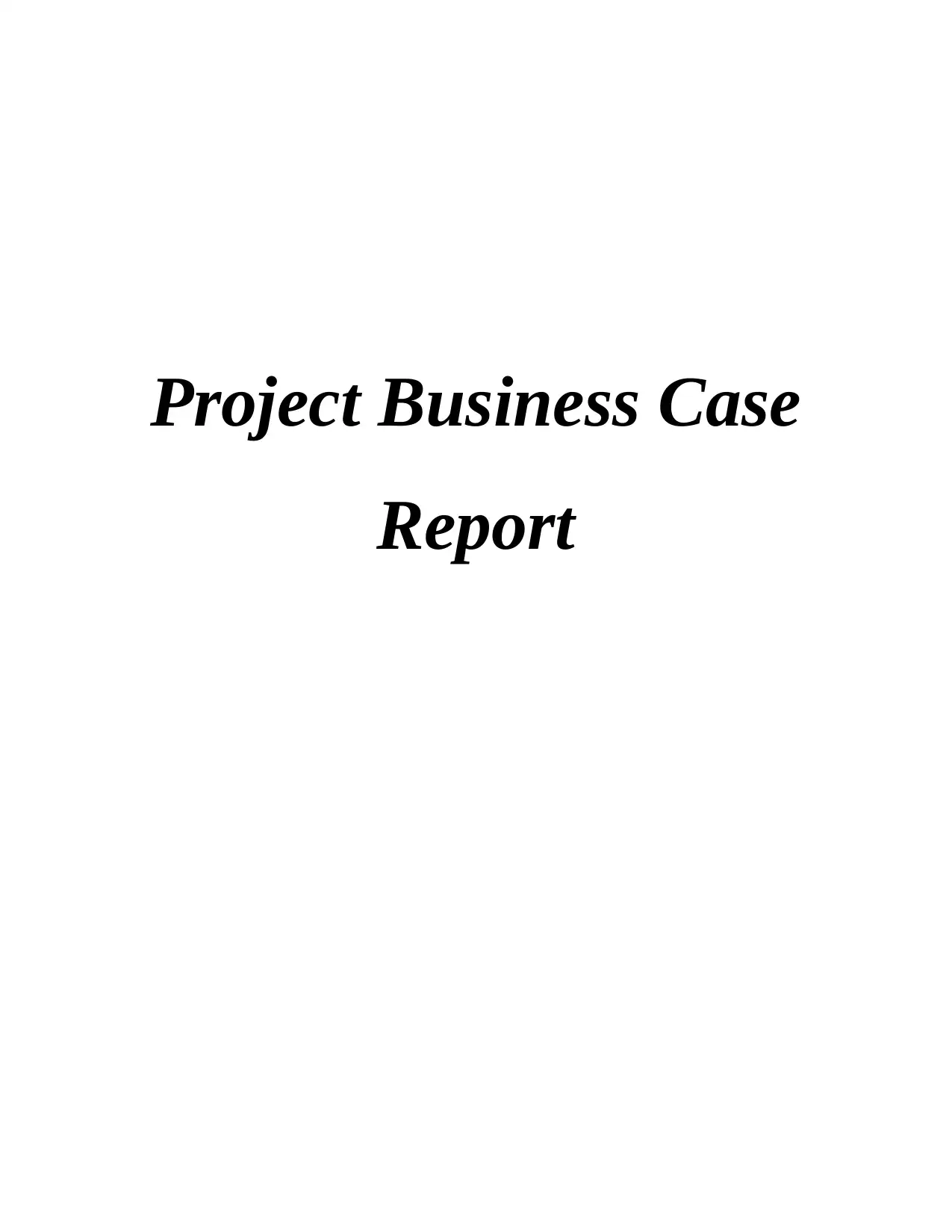
Project Business Case
Report
Report
Paraphrase This Document
Need a fresh take? Get an instant paraphrase of this document with our AI Paraphraser
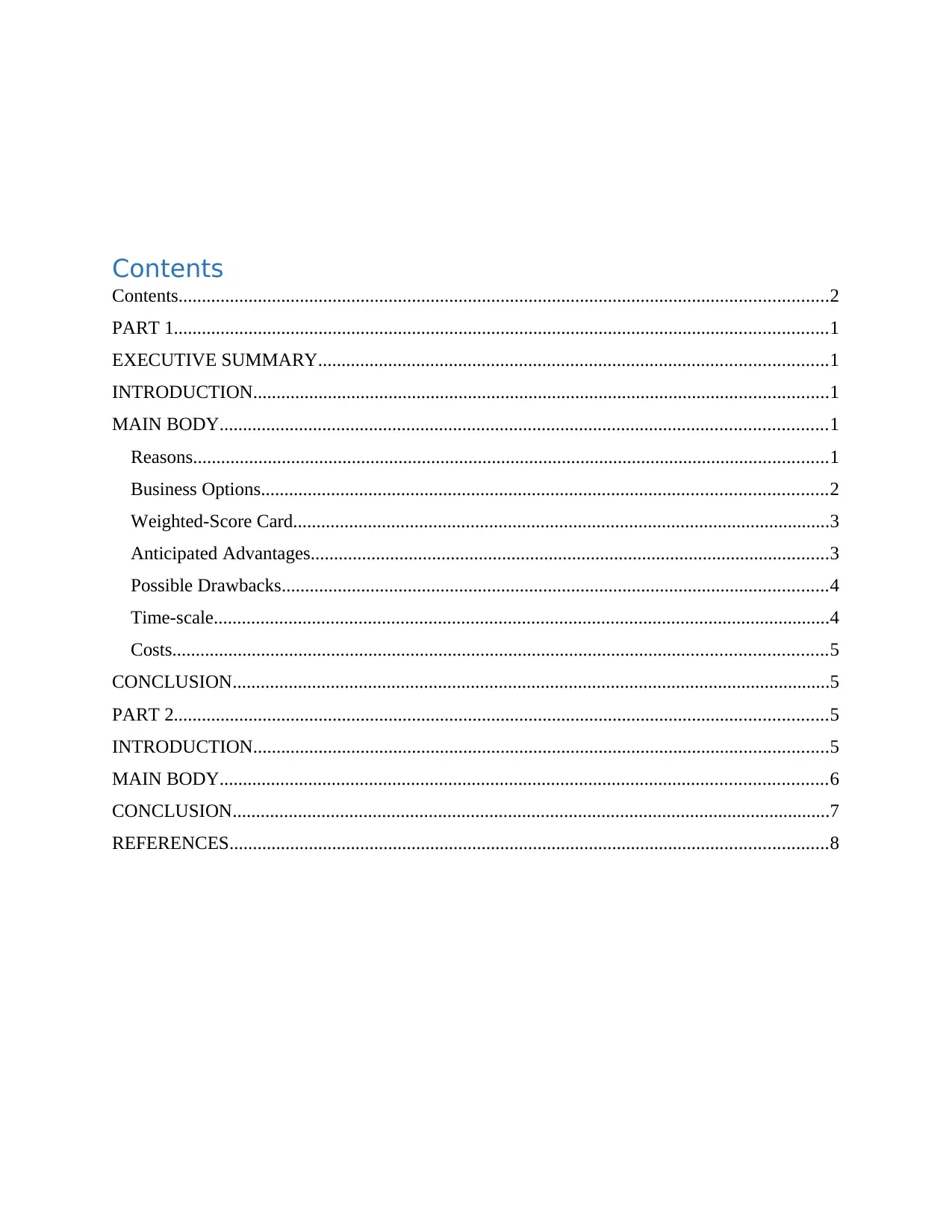
Contents
Contents...........................................................................................................................................2
PART 1............................................................................................................................................1
EXECUTIVE SUMMARY.............................................................................................................1
INTRODUCTION...........................................................................................................................1
MAIN BODY..................................................................................................................................1
Reasons........................................................................................................................................1
Business Options.........................................................................................................................2
Weighted-Score Card...................................................................................................................3
Anticipated Advantages...............................................................................................................3
Possible Drawbacks.....................................................................................................................4
Time-scale....................................................................................................................................4
Costs............................................................................................................................................5
CONCLUSION................................................................................................................................5
PART 2............................................................................................................................................5
INTRODUCTION...........................................................................................................................5
MAIN BODY..................................................................................................................................6
CONCLUSION................................................................................................................................7
REFERENCES................................................................................................................................8
Contents...........................................................................................................................................2
PART 1............................................................................................................................................1
EXECUTIVE SUMMARY.............................................................................................................1
INTRODUCTION...........................................................................................................................1
MAIN BODY..................................................................................................................................1
Reasons........................................................................................................................................1
Business Options.........................................................................................................................2
Weighted-Score Card...................................................................................................................3
Anticipated Advantages...............................................................................................................3
Possible Drawbacks.....................................................................................................................4
Time-scale....................................................................................................................................4
Costs............................................................................................................................................5
CONCLUSION................................................................................................................................5
PART 2............................................................................................................................................5
INTRODUCTION...........................................................................................................................5
MAIN BODY..................................................................................................................................6
CONCLUSION................................................................................................................................7
REFERENCES................................................................................................................................8
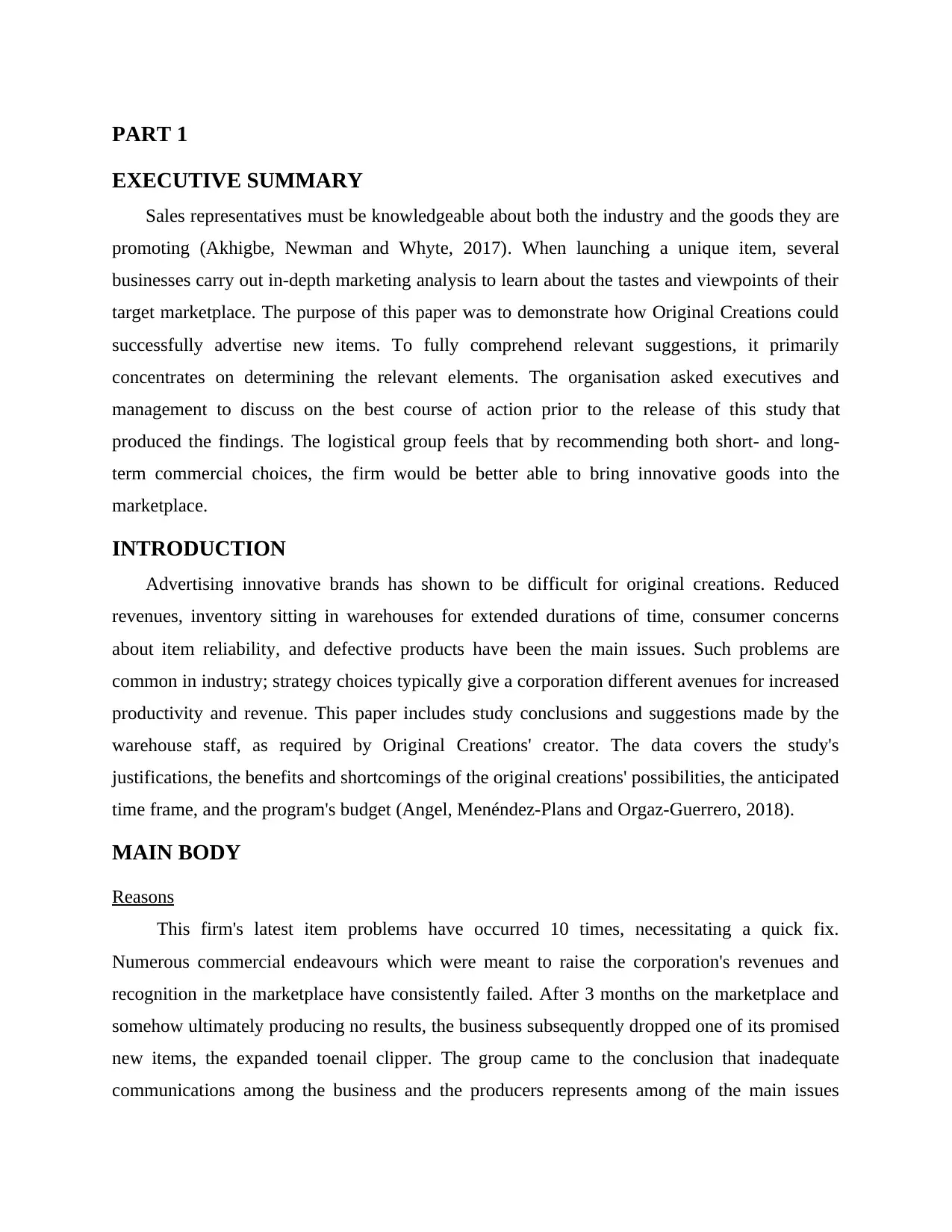
PART 1
EXECUTIVE SUMMARY
Sales representatives must be knowledgeable about both the industry and the goods they are
promoting (Akhigbe, Newman and Whyte, 2017). When launching a unique item, several
businesses carry out in-depth marketing analysis to learn about the tastes and viewpoints of their
target marketplace. The purpose of this paper was to demonstrate how Original Creations could
successfully advertise new items. To fully comprehend relevant suggestions, it primarily
concentrates on determining the relevant elements. The organisation asked executives and
management to discuss on the best course of action prior to the release of this study that
produced the findings. The logistical group feels that by recommending both short- and long-
term commercial choices, the firm would be better able to bring innovative goods into the
marketplace.
INTRODUCTION
Advertising innovative brands has shown to be difficult for original creations. Reduced
revenues, inventory sitting in warehouses for extended durations of time, consumer concerns
about item reliability, and defective products have been the main issues. Such problems are
common in industry; strategy choices typically give a corporation different avenues for increased
productivity and revenue. This paper includes study conclusions and suggestions made by the
warehouse staff, as required by Original Creations' creator. The data covers the study's
justifications, the benefits and shortcomings of the original creations' possibilities, the anticipated
time frame, and the program's budget (Angel, Menéndez-Plans and Orgaz-Guerrero, 2018).
MAIN BODY
Reasons
This firm's latest item problems have occurred 10 times, necessitating a quick fix.
Numerous commercial endeavours which were meant to raise the corporation's revenues and
recognition in the marketplace have consistently failed. After 3 months on the marketplace and
somehow ultimately producing no results, the business subsequently dropped one of its promised
new items, the expanded toenail clipper. The group came to the conclusion that inadequate
communications among the business and the producers represents among of the main issues
EXECUTIVE SUMMARY
Sales representatives must be knowledgeable about both the industry and the goods they are
promoting (Akhigbe, Newman and Whyte, 2017). When launching a unique item, several
businesses carry out in-depth marketing analysis to learn about the tastes and viewpoints of their
target marketplace. The purpose of this paper was to demonstrate how Original Creations could
successfully advertise new items. To fully comprehend relevant suggestions, it primarily
concentrates on determining the relevant elements. The organisation asked executives and
management to discuss on the best course of action prior to the release of this study that
produced the findings. The logistical group feels that by recommending both short- and long-
term commercial choices, the firm would be better able to bring innovative goods into the
marketplace.
INTRODUCTION
Advertising innovative brands has shown to be difficult for original creations. Reduced
revenues, inventory sitting in warehouses for extended durations of time, consumer concerns
about item reliability, and defective products have been the main issues. Such problems are
common in industry; strategy choices typically give a corporation different avenues for increased
productivity and revenue. This paper includes study conclusions and suggestions made by the
warehouse staff, as required by Original Creations' creator. The data covers the study's
justifications, the benefits and shortcomings of the original creations' possibilities, the anticipated
time frame, and the program's budget (Angel, Menéndez-Plans and Orgaz-Guerrero, 2018).
MAIN BODY
Reasons
This firm's latest item problems have occurred 10 times, necessitating a quick fix.
Numerous commercial endeavours which were meant to raise the corporation's revenues and
recognition in the marketplace have consistently failed. After 3 months on the marketplace and
somehow ultimately producing no results, the business subsequently dropped one of its promised
new items, the expanded toenail clipper. The group came to the conclusion that inadequate
communications among the business and the producers represents among of the main issues
⊘ This is a preview!⊘
Do you want full access?
Subscribe today to unlock all pages.

Trusted by 1+ million students worldwide
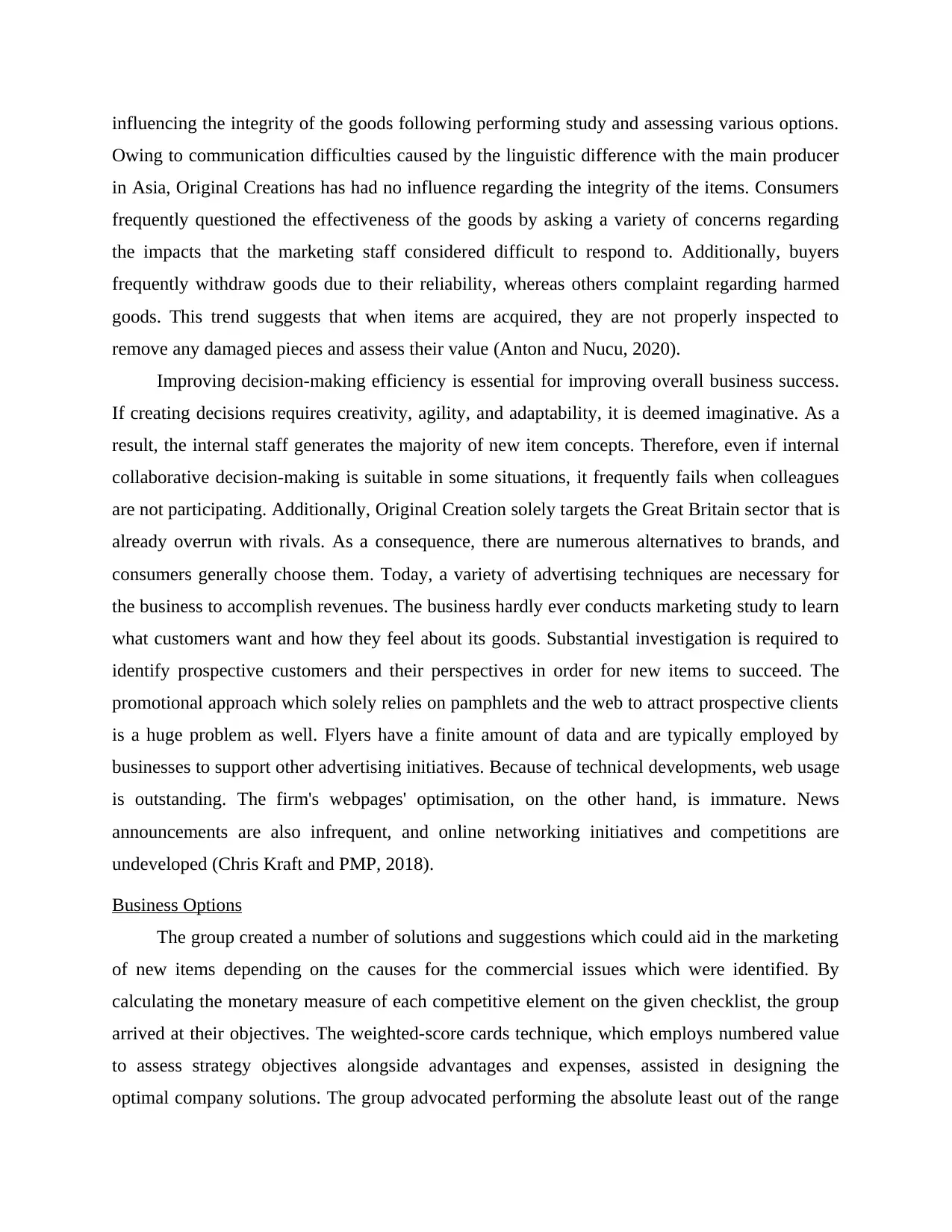
influencing the integrity of the goods following performing study and assessing various options.
Owing to communication difficulties caused by the linguistic difference with the main producer
in Asia, Original Creations has had no influence regarding the integrity of the items. Consumers
frequently questioned the effectiveness of the goods by asking a variety of concerns regarding
the impacts that the marketing staff considered difficult to respond to. Additionally, buyers
frequently withdraw goods due to their reliability, whereas others complaint regarding harmed
goods. This trend suggests that when items are acquired, they are not properly inspected to
remove any damaged pieces and assess their value (Anton and Nucu, 2020).
Improving decision-making efficiency is essential for improving overall business success.
If creating decisions requires creativity, agility, and adaptability, it is deemed imaginative. As a
result, the internal staff generates the majority of new item concepts. Therefore, even if internal
collaborative decision-making is suitable in some situations, it frequently fails when colleagues
are not participating. Additionally, Original Creation solely targets the Great Britain sector that is
already overrun with rivals. As a consequence, there are numerous alternatives to brands, and
consumers generally choose them. Today, a variety of advertising techniques are necessary for
the business to accomplish revenues. The business hardly ever conducts marketing study to learn
what customers want and how they feel about its goods. Substantial investigation is required to
identify prospective customers and their perspectives in order for new items to succeed. The
promotional approach which solely relies on pamphlets and the web to attract prospective clients
is a huge problem as well. Flyers have a finite amount of data and are typically employed by
businesses to support other advertising initiatives. Because of technical developments, web usage
is outstanding. The firm's webpages' optimisation, on the other hand, is immature. News
announcements are also infrequent, and online networking initiatives and competitions are
undeveloped (Chris Kraft and PMP, 2018).
Business Options
The group created a number of solutions and suggestions which could aid in the marketing
of new items depending on the causes for the commercial issues which were identified. By
calculating the monetary measure of each competitive element on the given checklist, the group
arrived at their objectives. The weighted-score cards technique, which employs numbered value
to assess strategy objectives alongside advantages and expenses, assisted in designing the
optimal company solutions. The group advocated performing the absolute least out of the range
Owing to communication difficulties caused by the linguistic difference with the main producer
in Asia, Original Creations has had no influence regarding the integrity of the items. Consumers
frequently questioned the effectiveness of the goods by asking a variety of concerns regarding
the impacts that the marketing staff considered difficult to respond to. Additionally, buyers
frequently withdraw goods due to their reliability, whereas others complaint regarding harmed
goods. This trend suggests that when items are acquired, they are not properly inspected to
remove any damaged pieces and assess their value (Anton and Nucu, 2020).
Improving decision-making efficiency is essential for improving overall business success.
If creating decisions requires creativity, agility, and adaptability, it is deemed imaginative. As a
result, the internal staff generates the majority of new item concepts. Therefore, even if internal
collaborative decision-making is suitable in some situations, it frequently fails when colleagues
are not participating. Additionally, Original Creation solely targets the Great Britain sector that is
already overrun with rivals. As a consequence, there are numerous alternatives to brands, and
consumers generally choose them. Today, a variety of advertising techniques are necessary for
the business to accomplish revenues. The business hardly ever conducts marketing study to learn
what customers want and how they feel about its goods. Substantial investigation is required to
identify prospective customers and their perspectives in order for new items to succeed. The
promotional approach which solely relies on pamphlets and the web to attract prospective clients
is a huge problem as well. Flyers have a finite amount of data and are typically employed by
businesses to support other advertising initiatives. Because of technical developments, web usage
is outstanding. The firm's webpages' optimisation, on the other hand, is immature. News
announcements are also infrequent, and online networking initiatives and competitions are
undeveloped (Chris Kraft and PMP, 2018).
Business Options
The group created a number of solutions and suggestions which could aid in the marketing
of new items depending on the causes for the commercial issues which were identified. By
calculating the monetary measure of each competitive element on the given checklist, the group
arrived at their objectives. The weighted-score cards technique, which employs numbered value
to assess strategy objectives alongside advantages and expenses, assisted in designing the
optimal company solutions. The group advocated performing the absolute least out of the range
Paraphrase This Document
Need a fresh take? Get an instant paraphrase of this document with our AI Paraphraser
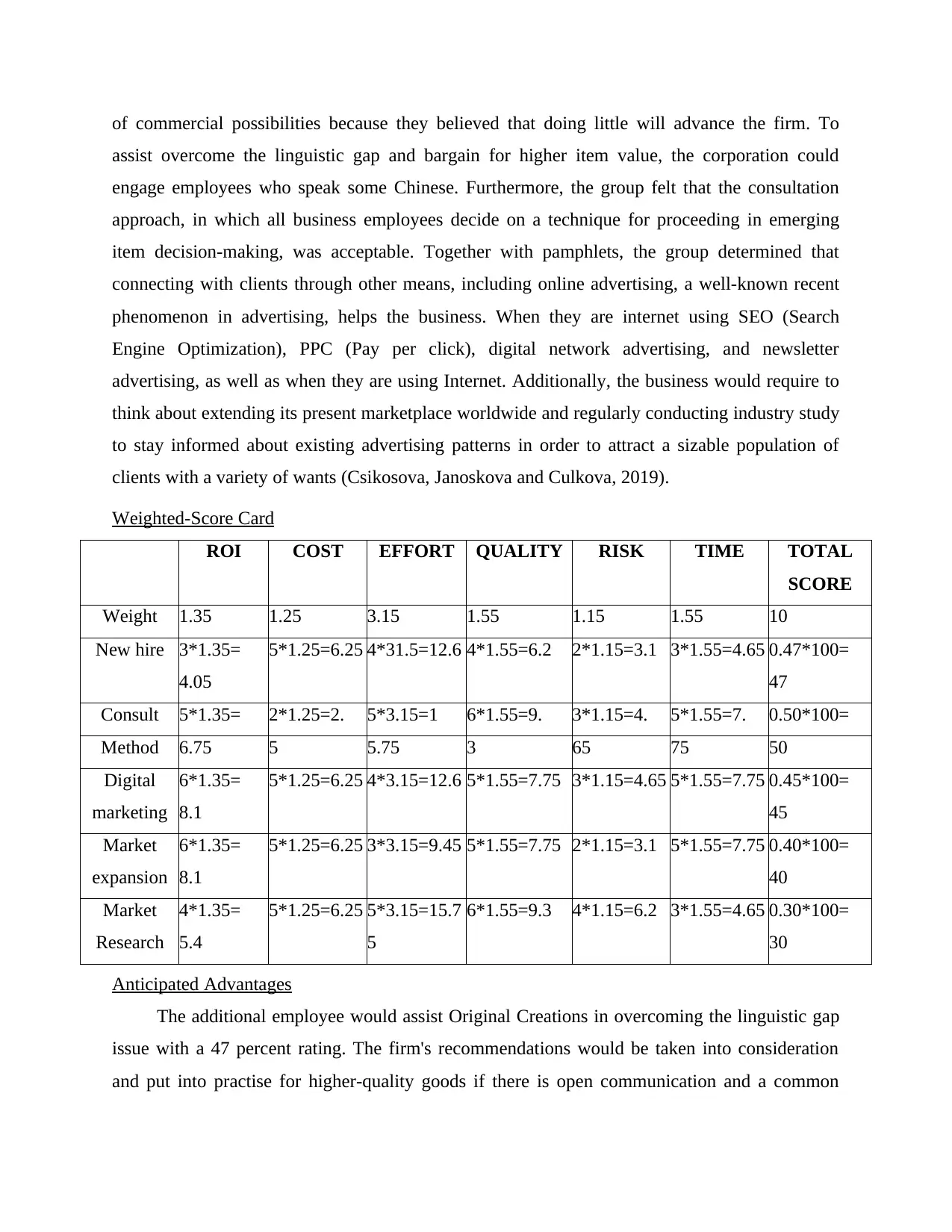
of commercial possibilities because they believed that doing little will advance the firm. To
assist overcome the linguistic gap and bargain for higher item value, the corporation could
engage employees who speak some Chinese. Furthermore, the group felt that the consultation
approach, in which all business employees decide on a technique for proceeding in emerging
item decision-making, was acceptable. Together with pamphlets, the group determined that
connecting with clients through other means, including online advertising, a well-known recent
phenomenon in advertising, helps the business. When they are internet using SEO (Search
Engine Optimization), PPC (Pay per click), digital network advertising, and newsletter
advertising, as well as when they are using Internet. Additionally, the business would require to
think about extending its present marketplace worldwide and regularly conducting industry study
to stay informed about existing advertising patterns in order to attract a sizable population of
clients with a variety of wants (Csikosova, Janoskova and Culkova, 2019).
Weighted-Score Card
ROI COST EFFORT QUALITY RISK TIME TOTAL
SCORE
Weight 1.35 1.25 3.15 1.55 1.15 1.55 10
New hire 3*1.35=
4.05
5*1.25=6.25 4*31.5=12.6 4*1.55=6.2 2*1.15=3.1 3*1.55=4.65 0.47*100=
47
Consult 5*1.35= 2*1.25=2. 5*3.15=1 6*1.55=9. 3*1.15=4. 5*1.55=7. 0.50*100=
Method 6.75 5 5.75 3 65 75 50
Digital
marketing
6*1.35=
8.1
5*1.25=6.25 4*3.15=12.6 5*1.55=7.75 3*1.15=4.65 5*1.55=7.75 0.45*100=
45
Market
expansion
6*1.35=
8.1
5*1.25=6.25 3*3.15=9.45 5*1.55=7.75 2*1.15=3.1 5*1.55=7.75 0.40*100=
40
Market
Research
4*1.35=
5.4
5*1.25=6.25 5*3.15=15.7
5
6*1.55=9.3 4*1.15=6.2 3*1.55=4.65 0.30*100=
30
Anticipated Advantages
The additional employee would assist Original Creations in overcoming the linguistic gap
issue with a 47 percent rating. The firm's recommendations would be taken into consideration
and put into practise for higher-quality goods if there is open communication and a common
assist overcome the linguistic gap and bargain for higher item value, the corporation could
engage employees who speak some Chinese. Furthermore, the group felt that the consultation
approach, in which all business employees decide on a technique for proceeding in emerging
item decision-making, was acceptable. Together with pamphlets, the group determined that
connecting with clients through other means, including online advertising, a well-known recent
phenomenon in advertising, helps the business. When they are internet using SEO (Search
Engine Optimization), PPC (Pay per click), digital network advertising, and newsletter
advertising, as well as when they are using Internet. Additionally, the business would require to
think about extending its present marketplace worldwide and regularly conducting industry study
to stay informed about existing advertising patterns in order to attract a sizable population of
clients with a variety of wants (Csikosova, Janoskova and Culkova, 2019).
Weighted-Score Card
ROI COST EFFORT QUALITY RISK TIME TOTAL
SCORE
Weight 1.35 1.25 3.15 1.55 1.15 1.55 10
New hire 3*1.35=
4.05
5*1.25=6.25 4*31.5=12.6 4*1.55=6.2 2*1.15=3.1 3*1.55=4.65 0.47*100=
47
Consult 5*1.35= 2*1.25=2. 5*3.15=1 6*1.55=9. 3*1.15=4. 5*1.55=7. 0.50*100=
Method 6.75 5 5.75 3 65 75 50
Digital
marketing
6*1.35=
8.1
5*1.25=6.25 4*3.15=12.6 5*1.55=7.75 3*1.15=4.65 5*1.55=7.75 0.45*100=
45
Market
expansion
6*1.35=
8.1
5*1.25=6.25 3*3.15=9.45 5*1.55=7.75 2*1.15=3.1 5*1.55=7.75 0.40*100=
40
Market
Research
4*1.35=
5.4
5*1.25=6.25 5*3.15=15.7
5
6*1.55=9.3 4*1.15=6.2 3*1.55=4.65 0.30*100=
30
Anticipated Advantages
The additional employee would assist Original Creations in overcoming the linguistic gap
issue with a 47 percent rating. The firm's recommendations would be taken into consideration
and put into practise for higher-quality goods if there is open communication and a common

concept with the Chinese supplier. The issue of inadequate grade is therefore more probably to
be resolved. Therefore, by involving all employees in decision-making who received a 50%
rating, the final outcome would be a workforce that is fully aware of the firm's objectives and
standards, working to meet established targets for overall efficiency. Consumer commitment
would rise along with revenue growth. Additionally, by assuring timely replies are available
through online advertising, the business would be able to engage additional consumers, reducing
item concerns and boosting selling. While industry development into other nations could take
some time, the organisation would experience tremendous development if consistency is
achieved. Additionally, marketing analysis would guarantee that the business is constantly
informed of any developments in the industry and the strategies used by its rivals to remain
relevant (Jordà, Schularick and Taylor, 2016).
Possible Drawbacks
Each excellent concept typically includes unavoidable repercussions. Although increasing
the marketplace is a workable approach to a substantial industry proportion, the business would
run into problems like taxation and regulation. In the additional nations, it would be expensive to
educate prospective employees owing to a different mentality. A competent worldwide
marketplace forecaster will therefore probably put a monetary strain on the business.
Additionally, the administration would designate and put aside a fund for online advertising
activities. In a comparable manner, the management would need to educate prospective
employees on how to use the internet and its digital networking platforms in order to provide
them the required abilities. The budgeting would have a detrimental effect on the corporation's
earnings for a period, however once things is on the marketplace, it would be lot simpler to
recoup the expenditures (Márquez-Chamorro, Resinas and Ruiz-Cortés, 2017).
Time-scale
The administration would analyse and choose objectives before implementing the
aforementioned suggestions. Yet, the business could plan and establish the essential processes
for 3 months depending on the group's assessments. The new employee could use the
consultation technique to inform decisions over that time. The advantages of the additional 3-
online advertising, industry growth, and industry analysis would be felt over a least of 3 years.
be resolved. Therefore, by involving all employees in decision-making who received a 50%
rating, the final outcome would be a workforce that is fully aware of the firm's objectives and
standards, working to meet established targets for overall efficiency. Consumer commitment
would rise along with revenue growth. Additionally, by assuring timely replies are available
through online advertising, the business would be able to engage additional consumers, reducing
item concerns and boosting selling. While industry development into other nations could take
some time, the organisation would experience tremendous development if consistency is
achieved. Additionally, marketing analysis would guarantee that the business is constantly
informed of any developments in the industry and the strategies used by its rivals to remain
relevant (Jordà, Schularick and Taylor, 2016).
Possible Drawbacks
Each excellent concept typically includes unavoidable repercussions. Although increasing
the marketplace is a workable approach to a substantial industry proportion, the business would
run into problems like taxation and regulation. In the additional nations, it would be expensive to
educate prospective employees owing to a different mentality. A competent worldwide
marketplace forecaster will therefore probably put a monetary strain on the business.
Additionally, the administration would designate and put aside a fund for online advertising
activities. In a comparable manner, the management would need to educate prospective
employees on how to use the internet and its digital networking platforms in order to provide
them the required abilities. The budgeting would have a detrimental effect on the corporation's
earnings for a period, however once things is on the marketplace, it would be lot simpler to
recoup the expenditures (Márquez-Chamorro, Resinas and Ruiz-Cortés, 2017).
Time-scale
The administration would analyse and choose objectives before implementing the
aforementioned suggestions. Yet, the business could plan and establish the essential processes
for 3 months depending on the group's assessments. The new employee could use the
consultation technique to inform decisions over that time. The advantages of the additional 3-
online advertising, industry growth, and industry analysis would be felt over a least of 3 years.
⊘ This is a preview!⊘
Do you want full access?
Subscribe today to unlock all pages.

Trusted by 1+ million students worldwide
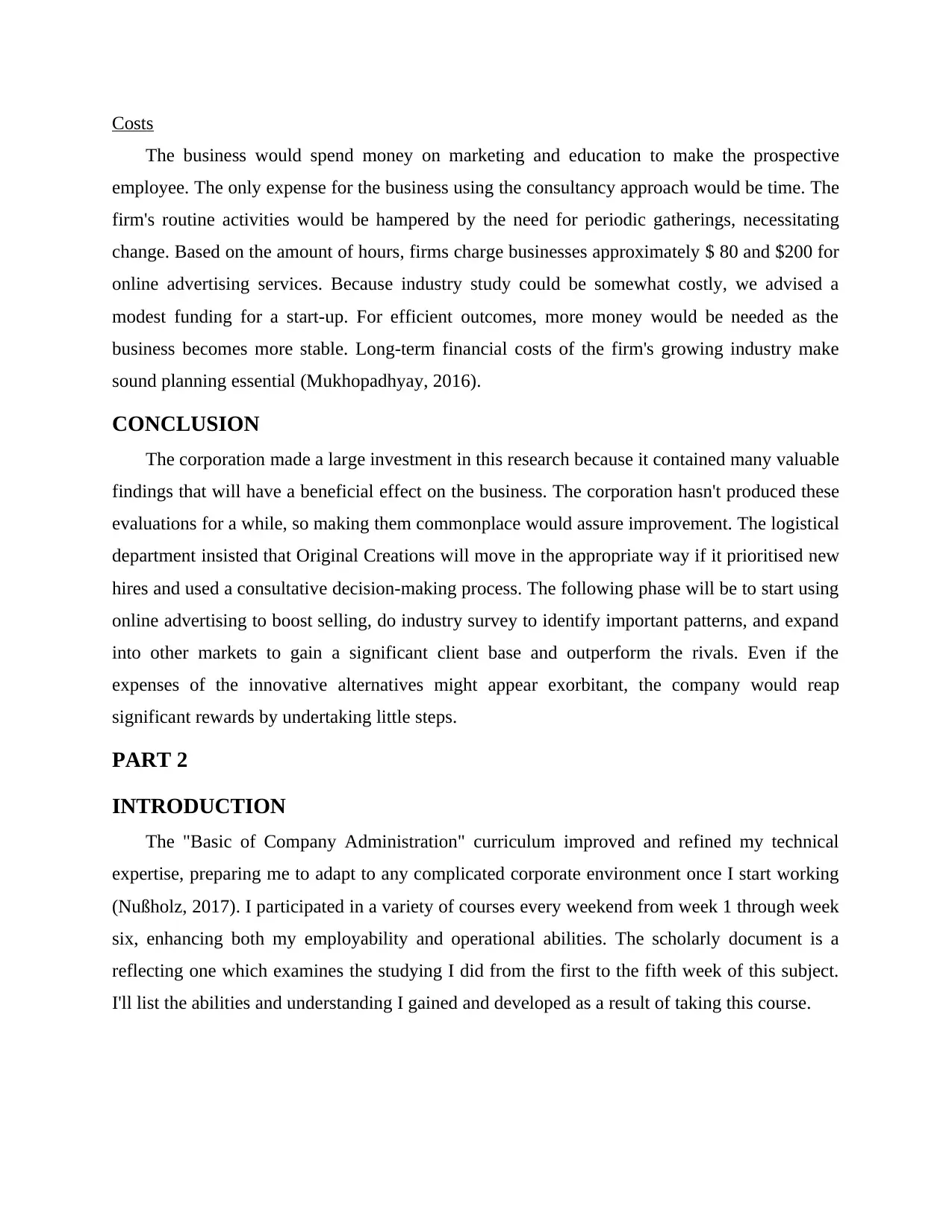
Costs
The business would spend money on marketing and education to make the prospective
employee. The only expense for the business using the consultancy approach would be time. The
firm's routine activities would be hampered by the need for periodic gatherings, necessitating
change. Based on the amount of hours, firms charge businesses approximately $ 80 and $200 for
online advertising services. Because industry study could be somewhat costly, we advised a
modest funding for a start-up. For efficient outcomes, more money would be needed as the
business becomes more stable. Long-term financial costs of the firm's growing industry make
sound planning essential (Mukhopadhyay, 2016).
CONCLUSION
The corporation made a large investment in this research because it contained many valuable
findings that will have a beneficial effect on the business. The corporation hasn't produced these
evaluations for a while, so making them commonplace would assure improvement. The logistical
department insisted that Original Creations will move in the appropriate way if it prioritised new
hires and used a consultative decision-making process. The following phase will be to start using
online advertising to boost selling, do industry survey to identify important patterns, and expand
into other markets to gain a significant client base and outperform the rivals. Even if the
expenses of the innovative alternatives might appear exorbitant, the company would reap
significant rewards by undertaking little steps.
PART 2
INTRODUCTION
The "Basic of Company Administration" curriculum improved and refined my technical
expertise, preparing me to adapt to any complicated corporate environment once I start working
(Nußholz, 2017). I participated in a variety of courses every weekend from week 1 through week
six, enhancing both my employability and operational abilities. The scholarly document is a
reflecting one which examines the studying I did from the first to the fifth week of this subject.
I'll list the abilities and understanding I gained and developed as a result of taking this course.
The business would spend money on marketing and education to make the prospective
employee. The only expense for the business using the consultancy approach would be time. The
firm's routine activities would be hampered by the need for periodic gatherings, necessitating
change. Based on the amount of hours, firms charge businesses approximately $ 80 and $200 for
online advertising services. Because industry study could be somewhat costly, we advised a
modest funding for a start-up. For efficient outcomes, more money would be needed as the
business becomes more stable. Long-term financial costs of the firm's growing industry make
sound planning essential (Mukhopadhyay, 2016).
CONCLUSION
The corporation made a large investment in this research because it contained many valuable
findings that will have a beneficial effect on the business. The corporation hasn't produced these
evaluations for a while, so making them commonplace would assure improvement. The logistical
department insisted that Original Creations will move in the appropriate way if it prioritised new
hires and used a consultative decision-making process. The following phase will be to start using
online advertising to boost selling, do industry survey to identify important patterns, and expand
into other markets to gain a significant client base and outperform the rivals. Even if the
expenses of the innovative alternatives might appear exorbitant, the company would reap
significant rewards by undertaking little steps.
PART 2
INTRODUCTION
The "Basic of Company Administration" curriculum improved and refined my technical
expertise, preparing me to adapt to any complicated corporate environment once I start working
(Nußholz, 2017). I participated in a variety of courses every weekend from week 1 through week
six, enhancing both my employability and operational abilities. The scholarly document is a
reflecting one which examines the studying I did from the first to the fifth week of this subject.
I'll list the abilities and understanding I gained and developed as a result of taking this course.
Paraphrase This Document
Need a fresh take? Get an instant paraphrase of this document with our AI Paraphraser
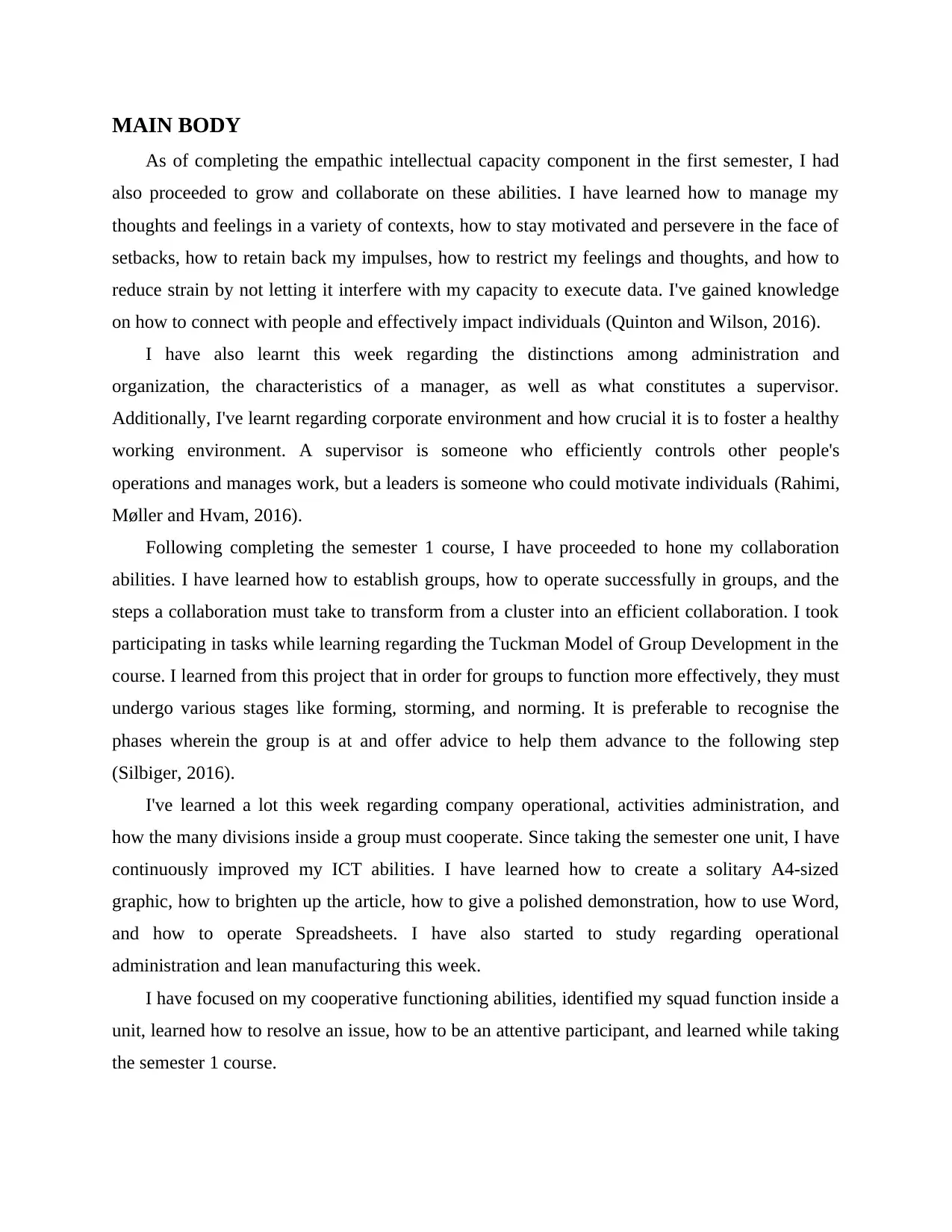
MAIN BODY
As of completing the empathic intellectual capacity component in the first semester, I had
also proceeded to grow and collaborate on these abilities. I have learned how to manage my
thoughts and feelings in a variety of contexts, how to stay motivated and persevere in the face of
setbacks, how to retain back my impulses, how to restrict my feelings and thoughts, and how to
reduce strain by not letting it interfere with my capacity to execute data. I've gained knowledge
on how to connect with people and effectively impact individuals (Quinton and Wilson, 2016).
I have also learnt this week regarding the distinctions among administration and
organization, the characteristics of a manager, as well as what constitutes a supervisor.
Additionally, I've learnt regarding corporate environment and how crucial it is to foster a healthy
working environment. A supervisor is someone who efficiently controls other people's
operations and manages work, but a leaders is someone who could motivate individuals (Rahimi,
Møller and Hvam, 2016).
Following completing the semester 1 course, I have proceeded to hone my collaboration
abilities. I have learned how to establish groups, how to operate successfully in groups, and the
steps a collaboration must take to transform from a cluster into an efficient collaboration. I took
participating in tasks while learning regarding the Tuckman Model of Group Development in the
course. I learned from this project that in order for groups to function more effectively, they must
undergo various stages like forming, storming, and norming. It is preferable to recognise the
phases wherein the group is at and offer advice to help them advance to the following step
(Silbiger, 2016).
I've learned a lot this week regarding company operational, activities administration, and
how the many divisions inside a group must cooperate. Since taking the semester one unit, I have
continuously improved my ICT abilities. I have learned how to create a solitary A4-sized
graphic, how to brighten up the article, how to give a polished demonstration, how to use Word,
and how to operate Spreadsheets. I have also started to study regarding operational
administration and lean manufacturing this week.
I have focused on my cooperative functioning abilities, identified my squad function inside a
unit, learned how to resolve an issue, how to be an attentive participant, and learned while taking
the semester 1 course.
As of completing the empathic intellectual capacity component in the first semester, I had
also proceeded to grow and collaborate on these abilities. I have learned how to manage my
thoughts and feelings in a variety of contexts, how to stay motivated and persevere in the face of
setbacks, how to retain back my impulses, how to restrict my feelings and thoughts, and how to
reduce strain by not letting it interfere with my capacity to execute data. I've gained knowledge
on how to connect with people and effectively impact individuals (Quinton and Wilson, 2016).
I have also learnt this week regarding the distinctions among administration and
organization, the characteristics of a manager, as well as what constitutes a supervisor.
Additionally, I've learnt regarding corporate environment and how crucial it is to foster a healthy
working environment. A supervisor is someone who efficiently controls other people's
operations and manages work, but a leaders is someone who could motivate individuals (Rahimi,
Møller and Hvam, 2016).
Following completing the semester 1 course, I have proceeded to hone my collaboration
abilities. I have learned how to establish groups, how to operate successfully in groups, and the
steps a collaboration must take to transform from a cluster into an efficient collaboration. I took
participating in tasks while learning regarding the Tuckman Model of Group Development in the
course. I learned from this project that in order for groups to function more effectively, they must
undergo various stages like forming, storming, and norming. It is preferable to recognise the
phases wherein the group is at and offer advice to help them advance to the following step
(Silbiger, 2016).
I've learned a lot this week regarding company operational, activities administration, and
how the many divisions inside a group must cooperate. Since taking the semester one unit, I have
continuously improved my ICT abilities. I have learned how to create a solitary A4-sized
graphic, how to brighten up the article, how to give a polished demonstration, how to use Word,
and how to operate Spreadsheets. I have also started to study regarding operational
administration and lean manufacturing this week.
I have focused on my cooperative functioning abilities, identified my squad function inside a
unit, learned how to resolve an issue, how to be an attentive participant, and learned while taking
the semester 1 course.
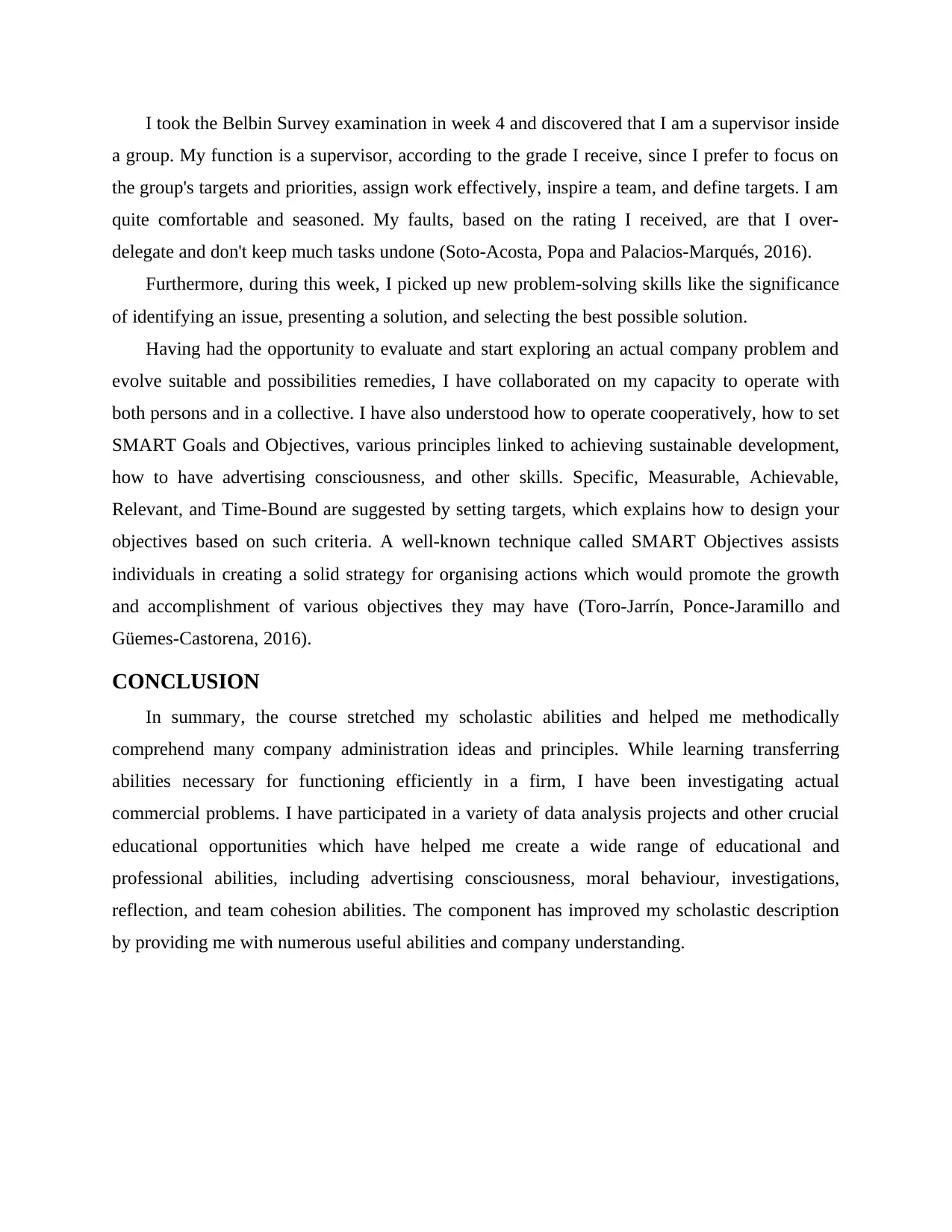
I took the Belbin Survey examination in week 4 and discovered that I am a supervisor inside
a group. My function is a supervisor, according to the grade I receive, since I prefer to focus on
the group's targets and priorities, assign work effectively, inspire a team, and define targets. I am
quite comfortable and seasoned. My faults, based on the rating I received, are that I over-
delegate and don't keep much tasks undone (Soto-Acosta, Popa and Palacios-Marqués, 2016).
Furthermore, during this week, I picked up new problem-solving skills like the significance
of identifying an issue, presenting a solution, and selecting the best possible solution.
Having had the opportunity to evaluate and start exploring an actual company problem and
evolve suitable and possibilities remedies, I have collaborated on my capacity to operate with
both persons and in a collective. I have also understood how to operate cooperatively, how to set
SMART Goals and Objectives, various principles linked to achieving sustainable development,
how to have advertising consciousness, and other skills. Specific, Measurable, Achievable,
Relevant, and Time-Bound are suggested by setting targets, which explains how to design your
objectives based on such criteria. A well-known technique called SMART Objectives assists
individuals in creating a solid strategy for organising actions which would promote the growth
and accomplishment of various objectives they may have (Toro-Jarrín, Ponce-Jaramillo and
Güemes-Castorena, 2016).
CONCLUSION
In summary, the course stretched my scholastic abilities and helped me methodically
comprehend many company administration ideas and principles. While learning transferring
abilities necessary for functioning efficiently in a firm, I have been investigating actual
commercial problems. I have participated in a variety of data analysis projects and other crucial
educational opportunities which have helped me create a wide range of educational and
professional abilities, including advertising consciousness, moral behaviour, investigations,
reflection, and team cohesion abilities. The component has improved my scholastic description
by providing me with numerous useful abilities and company understanding.
a group. My function is a supervisor, according to the grade I receive, since I prefer to focus on
the group's targets and priorities, assign work effectively, inspire a team, and define targets. I am
quite comfortable and seasoned. My faults, based on the rating I received, are that I over-
delegate and don't keep much tasks undone (Soto-Acosta, Popa and Palacios-Marqués, 2016).
Furthermore, during this week, I picked up new problem-solving skills like the significance
of identifying an issue, presenting a solution, and selecting the best possible solution.
Having had the opportunity to evaluate and start exploring an actual company problem and
evolve suitable and possibilities remedies, I have collaborated on my capacity to operate with
both persons and in a collective. I have also understood how to operate cooperatively, how to set
SMART Goals and Objectives, various principles linked to achieving sustainable development,
how to have advertising consciousness, and other skills. Specific, Measurable, Achievable,
Relevant, and Time-Bound are suggested by setting targets, which explains how to design your
objectives based on such criteria. A well-known technique called SMART Objectives assists
individuals in creating a solid strategy for organising actions which would promote the growth
and accomplishment of various objectives they may have (Toro-Jarrín, Ponce-Jaramillo and
Güemes-Castorena, 2016).
CONCLUSION
In summary, the course stretched my scholastic abilities and helped me methodically
comprehend many company administration ideas and principles. While learning transferring
abilities necessary for functioning efficiently in a firm, I have been investigating actual
commercial problems. I have participated in a variety of data analysis projects and other crucial
educational opportunities which have helped me create a wide range of educational and
professional abilities, including advertising consciousness, moral behaviour, investigations,
reflection, and team cohesion abilities. The component has improved my scholastic description
by providing me with numerous useful abilities and company understanding.
⊘ This is a preview!⊘
Do you want full access?
Subscribe today to unlock all pages.

Trusted by 1+ million students worldwide
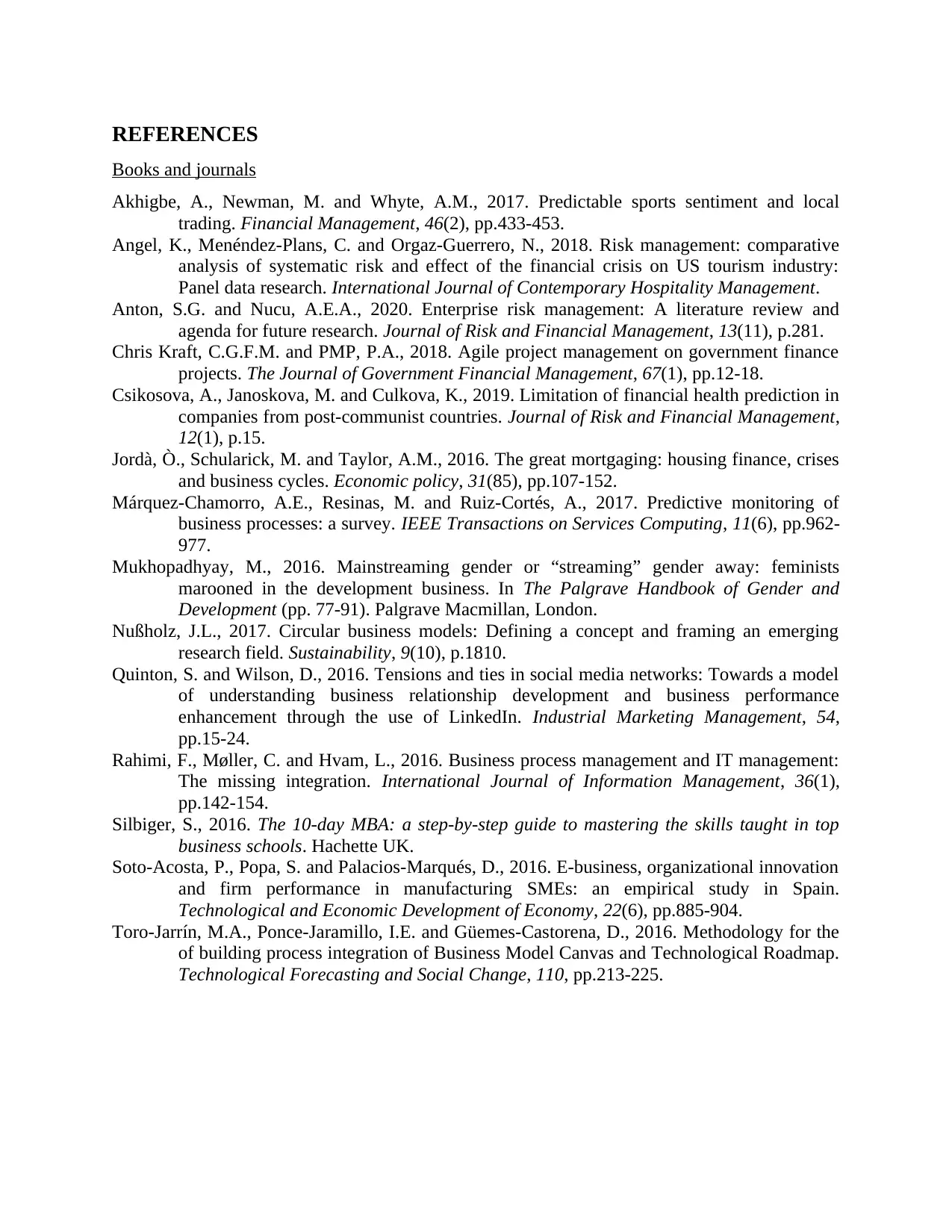
REFERENCES
Books and journals
Akhigbe, A., Newman, M. and Whyte, A.M., 2017. Predictable sports sentiment and local
trading. Financial Management, 46(2), pp.433-453.
Angel, K., Menéndez-Plans, C. and Orgaz-Guerrero, N., 2018. Risk management: comparative
analysis of systematic risk and effect of the financial crisis on US tourism industry:
Panel data research. International Journal of Contemporary Hospitality Management.
Anton, S.G. and Nucu, A.E.A., 2020. Enterprise risk management: A literature review and
agenda for future research. Journal of Risk and Financial Management, 13(11), p.281.
Chris Kraft, C.G.F.M. and PMP, P.A., 2018. Agile project management on government finance
projects. The Journal of Government Financial Management, 67(1), pp.12-18.
Csikosova, A., Janoskova, M. and Culkova, K., 2019. Limitation of financial health prediction in
companies from post-communist countries. Journal of Risk and Financial Management,
12(1), p.15.
Jordà, Ò., Schularick, M. and Taylor, A.M., 2016. The great mortgaging: housing finance, crises
and business cycles. Economic policy, 31(85), pp.107-152.
Márquez-Chamorro, A.E., Resinas, M. and Ruiz-Cortés, A., 2017. Predictive monitoring of
business processes: a survey. IEEE Transactions on Services Computing, 11(6), pp.962-
977.
Mukhopadhyay, M., 2016. Mainstreaming gender or “streaming” gender away: feminists
marooned in the development business. In The Palgrave Handbook of Gender and
Development (pp. 77-91). Palgrave Macmillan, London.
Nußholz, J.L., 2017. Circular business models: Defining a concept and framing an emerging
research field. Sustainability, 9(10), p.1810.
Quinton, S. and Wilson, D., 2016. Tensions and ties in social media networks: Towards a model
of understanding business relationship development and business performance
enhancement through the use of LinkedIn. Industrial Marketing Management, 54,
pp.15-24.
Rahimi, F., Møller, C. and Hvam, L., 2016. Business process management and IT management:
The missing integration. International Journal of Information Management, 36(1),
pp.142-154.
Silbiger, S., 2016. The 10-day MBA: a step-by-step guide to mastering the skills taught in top
business schools. Hachette UK.
Soto-Acosta, P., Popa, S. and Palacios-Marqués, D., 2016. E-business, organizational innovation
and firm performance in manufacturing SMEs: an empirical study in Spain.
Technological and Economic Development of Economy, 22(6), pp.885-904.
Toro-Jarrín, M.A., Ponce-Jaramillo, I.E. and Güemes-Castorena, D., 2016. Methodology for the
of building process integration of Business Model Canvas and Technological Roadmap.
Technological Forecasting and Social Change, 110, pp.213-225.
Books and journals
Akhigbe, A., Newman, M. and Whyte, A.M., 2017. Predictable sports sentiment and local
trading. Financial Management, 46(2), pp.433-453.
Angel, K., Menéndez-Plans, C. and Orgaz-Guerrero, N., 2018. Risk management: comparative
analysis of systematic risk and effect of the financial crisis on US tourism industry:
Panel data research. International Journal of Contemporary Hospitality Management.
Anton, S.G. and Nucu, A.E.A., 2020. Enterprise risk management: A literature review and
agenda for future research. Journal of Risk and Financial Management, 13(11), p.281.
Chris Kraft, C.G.F.M. and PMP, P.A., 2018. Agile project management on government finance
projects. The Journal of Government Financial Management, 67(1), pp.12-18.
Csikosova, A., Janoskova, M. and Culkova, K., 2019. Limitation of financial health prediction in
companies from post-communist countries. Journal of Risk and Financial Management,
12(1), p.15.
Jordà, Ò., Schularick, M. and Taylor, A.M., 2016. The great mortgaging: housing finance, crises
and business cycles. Economic policy, 31(85), pp.107-152.
Márquez-Chamorro, A.E., Resinas, M. and Ruiz-Cortés, A., 2017. Predictive monitoring of
business processes: a survey. IEEE Transactions on Services Computing, 11(6), pp.962-
977.
Mukhopadhyay, M., 2016. Mainstreaming gender or “streaming” gender away: feminists
marooned in the development business. In The Palgrave Handbook of Gender and
Development (pp. 77-91). Palgrave Macmillan, London.
Nußholz, J.L., 2017. Circular business models: Defining a concept and framing an emerging
research field. Sustainability, 9(10), p.1810.
Quinton, S. and Wilson, D., 2016. Tensions and ties in social media networks: Towards a model
of understanding business relationship development and business performance
enhancement through the use of LinkedIn. Industrial Marketing Management, 54,
pp.15-24.
Rahimi, F., Møller, C. and Hvam, L., 2016. Business process management and IT management:
The missing integration. International Journal of Information Management, 36(1),
pp.142-154.
Silbiger, S., 2016. The 10-day MBA: a step-by-step guide to mastering the skills taught in top
business schools. Hachette UK.
Soto-Acosta, P., Popa, S. and Palacios-Marqués, D., 2016. E-business, organizational innovation
and firm performance in manufacturing SMEs: an empirical study in Spain.
Technological and Economic Development of Economy, 22(6), pp.885-904.
Toro-Jarrín, M.A., Ponce-Jaramillo, I.E. and Güemes-Castorena, D., 2016. Methodology for the
of building process integration of Business Model Canvas and Technological Roadmap.
Technological Forecasting and Social Change, 110, pp.213-225.
1 out of 10
Related Documents
Your All-in-One AI-Powered Toolkit for Academic Success.
+13062052269
info@desklib.com
Available 24*7 on WhatsApp / Email
![[object Object]](/_next/static/media/star-bottom.7253800d.svg)
Unlock your academic potential
Copyright © 2020–2025 A2Z Services. All Rights Reserved. Developed and managed by ZUCOL.




